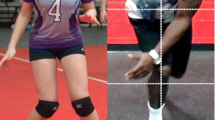Abstract
Anterior cruciate ligament (ACL) injuries are extremely common and lead to devastating consequences including recovery time and time away from sport, risks of surgery for patients who elect to undergo ACL reconstruction, and increased risk of osteoarthritis of the knee. There is now significant evidence demonstrating that the risk of this injury can be dramatically decreased by doing an exercise program emphasizing core strength, balance, proprioception, and safe movement patterns. Despite the medical evidence that has accumulated, these programs are generally not widely used in most places in the world.
You have full access to this open access chapter, Download chapter PDF
Similar content being viewed by others
Anterior cruciate ligament (ACL) injuries are extremely common and lead to devastating consequences including recovery time and time away from sport, risks of surgery for patients who elect to undergo ACL reconstruction, and increased risk of osteoarthritis of the knee. There is now significant evidence demonstrating that the risk of this injury can be dramatically decreased by doing an exercise program emphasizing core strength, balance, proprioception, and safe movement patterns. Despite the medical evidence that has accumulated, these programs are generally not widely used in most places in the world.
The reason for this is likely multifactorial. In general, people do not like taking action that requires discipline and effort in order to prevent medical problems. For example, patients generally prefer to take medication to reduce their cholesterol, rather than severely modifying their diet to achieve a similar result.
ACL injury prevention programs are different. The decision to implement is made by the coaches and training staff, rather than the athletes. Nevertheless, the team leaders often have other priorities and may have difficulty relating the exercises to injuries prevented and keeping their athletes on the field.
The best approach to disseminating this information in order to have athletes best prepared for injury-free practice and competition remains unknown. This is a critical issue that will be faced by sports medicine physicians and public health advocates in the future.
A similar example is seatbelts that improve safety, when traveling in a vehicle. A few decades ago, seatbelts didn’t exist, and only more recently have they become very commonly used. With the passage of time, injury prevention strategies can become routine and standard. We must improve sports injury prevention strategies to arrive at a similar level of compliance. As surgeons, we can repair ACL-injured knees one at a time; however, with wide implementation of injury prevention strategies, we can save thousands of knees without lifting a knife.
Author information
Authors and Affiliations
Corresponding author
Editor information
Editors and Affiliations
Rights and permissions
Copyright information
© 2020 ISAKOS
About this chapter
Cite this chapter
Marx, R.G. (2020). Why Are ACL Injury Prevention Programs Not Being Implemented More Widely?. In: Devitt, B., Karahan, M., Espregueira-Mendes, J. (eds) The Future of Orthopaedic Sports Medicine . Springer, Cham. https://doi.org/10.1007/978-3-030-28976-8_46
Download citation
DOI: https://doi.org/10.1007/978-3-030-28976-8_46
Published:
Publisher Name: Springer, Cham
Print ISBN: 978-3-030-28975-1
Online ISBN: 978-3-030-28976-8
eBook Packages: MedicineMedicine (R0)




